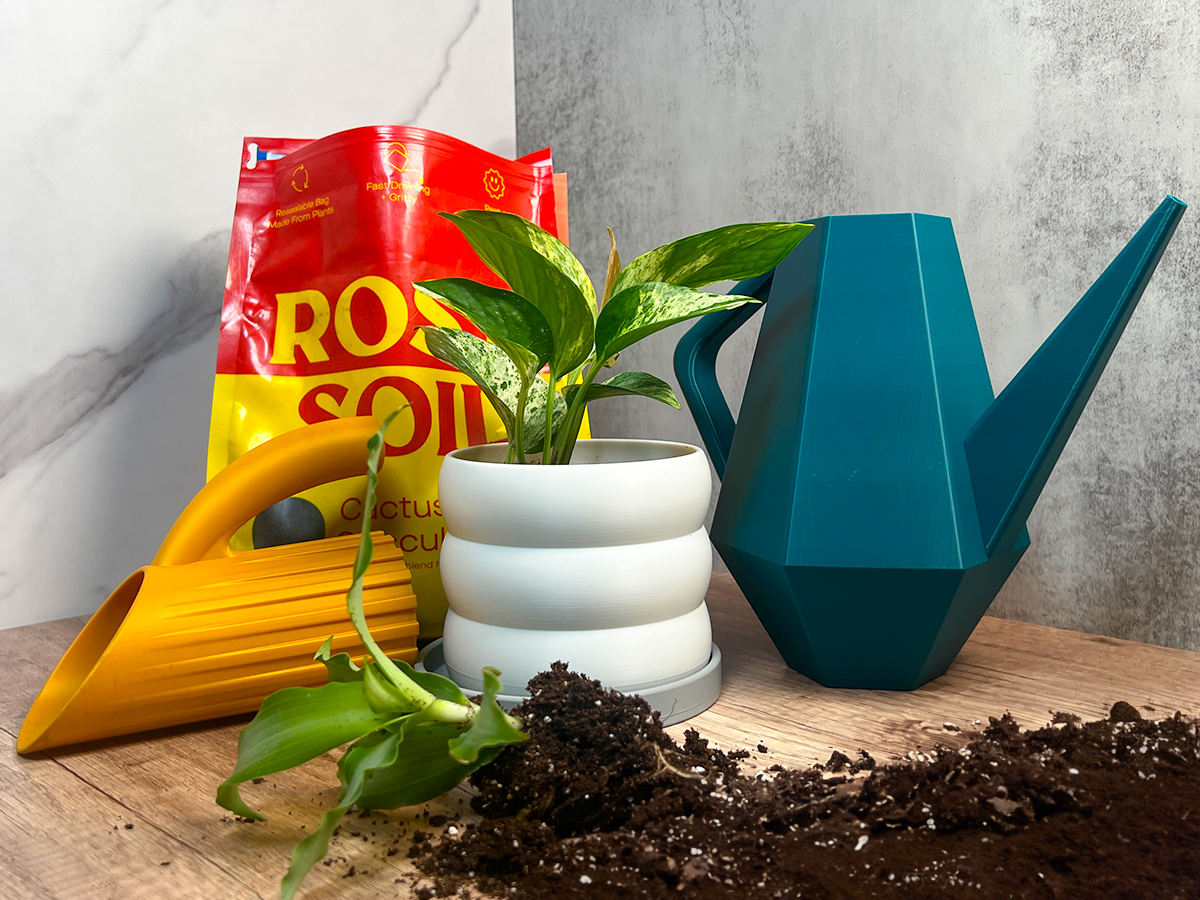
A Guide to 3D-Printed Moss Poles for Monstera, Pothos, and Other Climbing Plants
Moss Poles and Climbing Plants: A Match Made in Gardening Heaven
If you're a passionate gardener, you've likely heard of or might even have a moss pole in your house. But if you've recently developed a passion for plants, you must get your hands on one of these fantastic tools since it will be your climbing plant's greatest buddy and most significant ally and savior, promoting vertical development. Usually covered in moss or coir, these poles have rough surfaces that allow plant roots to adhere to and ascend. It replicates the plant's natural habitat and encourages healthy growth and development, helping it grow upward and producing a more visually beautiful display.
Moss poles have often been pre-built, with restricted design and utility. However, because of technological developments, 3D-printed modular moss poles are currently a ground-breaking way to support climbing plants. These cutting-edge poles offer configurable configurations, allowing plant owners to match the pole to their particular plants' unique requirements and development patterns.
In this guide, we’ll dive into how a moss pole is a game changer for your plant care routine.
What's In This Post
What is a 3D-Printed Moss Pole?
Created using 3D printing technology, 3D-printed moss poles are creative plant support structures. They have a modular construction that is simple to modify and extend as needed, unlike traditional moss poles, which are usually made from a solid piece of material covered in moss or coir. These poles' interconnecting segments enable height adjustments and configuration customization, enabling them to be tailored to the unique growth requirements and patterns of various climbing plants.
Comparison to Traditional Moss Poles
Conventional Moss Poles: Typically composed of a solid substance like plastic or wood covered in moss or coconut coir. Their limited adaptation as the plant grows results from their set sizes and designs.
3D-Printed Moss Poles: Constructed with cutting-edge 3D printing methods, the modular poles may be expanded or rearranged. The design incorporates elements such as leafy stem supports to better accommodate the growth tendencies of climbing plants.
Advantages of Using 3D-Printed Moss Poles
Customizability and Modular Design: 3D-printed moss poles are unmatched in their customizability. Thanks to their modular design, users may add or remove pieces to suit the precise height and structure required for their plants. Because of their adaptability, you may design a support system that develops with your plant and offers steady, ideal support.
Eco-friendliness and Durability: The materials used to make these poles are strong and can bear the weight of climbing plants and the weather. By being long-lasting, 3D-printed moss poles provide your plant's long-term support, unlike regular ones that could deteriorate with time. Furthermore, many 3D-printed moss poles are composed of environmentally safe materials, which lessens the effect of your gardening activities on the environment.
Better Protection for Climbing Plants: The unique construction of 3D-printed moss poles offers climbing plants more support. The rough exterior and overlapping segments provide multiple attachment points for plant roots to promote healthy, vertical, and solid growth. These poles' modular design also improves weight distribution and support, avoiding harm to the plant and the pole itself.
A Step-by-Step Guide to Assembling a 3D-Printed Modular Moss Pole System

Step 1: Line Up Pieces
Begin by aligning the pieces you want to connect. This could involve different parts of the moss pole such as the main body segments, the bottom spike, or the top cap. Each piece has 3 nubs that fit into corresponding twist lock ports on the other piece. Ensure these nubs are positioned directly in line with the ports.
Actions:
- Identify: Identify the parts you need to assemble based on the desired height for your plant.
- Align: Match the 3 nubs on one piece with the 3 ports on the other piece.
- Position: Ensure each nub is lined up with its corresponding port.

Step 2: Insert Leafy Support Spacer
Once the pieces are aligned, place a leafy support spacer between them. This spacer ring helps provide stability for the moss pole and also spins so its leafy support stems hold onto any large stems to support and hold any plants that will climb the pole.
Actions:
- Grab: Secure the leafy support spacer.
- Place: Position it between the two aligned pole pieces, opting to rest it on either the bottom portion of the moss pole's body piece or above the nubs on the top cap's bottom piece for easier placement.
- Ensure: Verify that it sits evenly to ensure consistent and reliable support.

Step 3: Connect and Twist to Lock
With the spacer in place and the pieces aligned, connect them by fitting together and twisting. Twisting to the right will lock the pieces and spacer securely; twisting to the left will unlock them if adjustments are needed.
Actions:
- Fit: Firmly press parts together while matching the 3 nubs with the 3 ports on the other piecetogether with the spacer in between.
- Twist: Turn the top piece to the right to lock it (right is tight).
- Adjust: If needed, twist to the left to unlock (left is loose).

Step 4: Fill Moss Pole with Substrate and Stake in Pot
After connecting and locking the pieces, fill the moss pole with the substrate that best suits your plant and stake it in the pot.
Actions:
- Fill: Carefully pour and gently pack the chosen substrate into the open end of the moss pole until it's filled.
- Stake: Secure the filled moss pole in the pot, adjusting positioning as needed.
- Adjust Leafy Stem Supports: Once staked, position supports to hold stems close, promoting rooting, stability, and growth.
- Water the Substrate: After staking the moss pole, water the substrate thoroughly to ensure proper moisture levels for your plant.

Step 5: Repeat for Additional Pieces
Repeat the previous steps to add more pieces to the moss pole until you reach the desired height or as your plant grows. Each additional piece will require alignment, insertion of a support spacer, and twisting to lock in place.
Actions:
- Gather: Collect the next piece to be added.
- Align: Match the nubs and ports as before.
- Insert: Place another leafy support spacer between the new piece and the assembled pole.
- Connect: Press and twist to lock the new piece in place.
- Continue: Repeat until your moss pole is at the desired height.

Congratulations! You've successfully assembled your 3D-printed moss pole. This sturdy and supportive structure is now ready to help your plants thrive, providing an ideal environment for them to climb and grow.
Ensuring your substrates stay moist is key to a thriving moss pole. To lend a hand with this, just unlock the top cap of our moss pole and give the substrate a drink whenever it's thirsty. We'll dive into this in more detail in the next section.
And hey, if you haven't checked out our Moss pole system yet, why not take a peek?
Click the button below and let's get your plants the support they deserve!
Prepping Substrates for Modular Moss Pole Filling
Selecting the Appropriate Substrate
Choosing a suitable substrate is essential when filling your modular moss pole. There are several substrates available, and each has advantages and disadvantages of its own:

Peat Moss:
- Pros: Packed with organic matter, peat moss holds moisture well, encouraging strong root development.
- Cons: Gathering peat moss may hurt the environment and lead to flooding if not handled appropriately.
Coconut Coir:
- Pros: Coconut coir retains moisture well and gives plant roots a solid grip, making it an excellent material for moss poles. It is also biodegradable and sustainable.
- Cons: Compared to other substrates, it might dry up more quickly. Therefore, regular watering may be necessary.
Sphagnum Moss:
- Pros: Sphagnum moss is excellent for plants that need a continuously wet environment. It is highly absorbent and effectively holds moisture. It also offers a beautiful and natural appearance.
- Cons: Sphagnum moss can be more costly and may become less effective due to compacting.
Blending Substrates
You may mix and match different substrates to provide your plants with the best possible growth environment and maximize their advantages. For instance, combining sphagnum moss with coconut coir can offer structure and moisture retention, giving your climbing plants the support they require.
How to Blend Substrates for Monstera:
- Assemble Materials: Gather sphagnum moss and coconut coir.
- Mix Completion: Evenly distribute the substrates in equal quantities in a big container.
- Wet the Mix: To simplify the substrate mix, lightly dampen it.
- Fill the Pole: Stuff the mixed substrate into the segments of your modular moss pole, making sure to pack it firmly yet loosely. This allows adequate airflow while still providing enough support for the roots.
Teaching Climbers to Cling to Moss Poles
Promoting the natural climbing habit of climbing plants is necessary to teach them to cling to moss poles. Here are some effective techniques:
- Use Leafy Stem Supports: Our moss poles come with leafy stem supports that gently hold the plant stems close to the pole. These supports help train a plant like Monstera to root into the pole and grow upwards effectively.
- Use Soft Ties, Plant Clips, Velcro Strips, and Twisting Zip-Ties: Soft ties and plant clips are gentle on the stems, ensuring they don't get damaged. Velcro strips offer adjustable support, making it easy to reposition as the plant grows. Leafy Stem Support Twisting Zip-Ties are another excellent option. The spinning leaf support design adjusts to the angle of your plant's growth, ensuring that no matter how your plant twists and turns, the stems are gently held in place. This innovative feature promotes healthy growth without restrictions, allowing your plants to reach their full potential without drooping or sprawling.
Why Monstera and Other Climbers Need Moss Poles
Without a moss pole, many climbing plants like Monstera deliciosa, Monstera adansonii, Pothos, Philodendron, or the Swiss Cheese Plant wouldn't be able to reach maturity in their leaves. These poles are particularly crucial for achieving larger leaves in these types of plants. As these plants climb and root into the moss pole, they develop more significant and mature foliage, enhancing their overall appearance and health.
Quick Tips
- Monitor Moisture Levels: Ensure the substrate in your moss pole is damp but not soggy. Overwatering can lead to root rot, while underwatering can cause the substrate to dry out too quickly.
- Regularly Check Attachments: As your plant grows, adjust the ties, clips, or Velcro strips to ensure the stems are securely but gently attached to the moss pole.
- Refresh Substrates Periodically: Substrates can condense or degrade over time. Regularly check and refresh the substrate within your moss pole to maintain optimal moisture and nutrient levels.
Final Words
Now that we've walked through assembling your moss pole and delved into the world of substrate options, you're all set to elevate your climbing plants' growth journey. And guess what? If you haven't already guessed by this blog post, Leafy Cove has just unveiled their latest collection of modular moss poles, ready to accompany your plant parenting adventure! These 3D-printed poles with leafy stem support are like the best pals your plants could ask for, providing the perfect blend of style and functionality. So, why wait? Dive in, explore Leafy Cove's range, and find the ideal match for your leafy buddies!

